The world must invest in mangroves Comment The Ecologist
Post on: 23 Июнь, 2015 No Comment

As the IPCC prepares to launch its latest climate report, Mark Spalding reports that mangrove swaps don’t just protect coastlines from storms, flooding and erosion — they also sequester huge tonnages of carbon. And that makes them a super-smart investment.
If you had a dollar to invest in carbon futures, my strongest advice of all would be to invest in preventing mangrove loss, or even restoration.
My colleagues and I have worked out how much carbon there is in the world’s mangrove forests. give or take a bit. And we mapped it. And here’s why these findings are tremendously important.
They quantify what some of us in marine conservation have been saying for a decade or more: that mangrove forests are among the most carbon rich habitats on the planet; and that, although they occupy just a fraction of the world’s surface, they pack a punch.
Anyone concerned about preserving nature’s value — carbon sequestration and all the other benefits mangroves provide us — needs to think hard about this.
Double the biomass of tropical forests overall
Because on average, mangroves have double the living biomass of tropical forests overall. This means that if you want to slow carbon emissions, one of the first places you could look would be in the mangroves.
Stop an acre of loss here, and you will achieve a much bigger win than in many other areas. But the average also hides a host of variance. Look at the map (right) and you’ll see that there’s a tenfold range in aboveground biomass.
As we make our increasingly bold statements about the importance of mangrove biomass — or indeed around any ecosystem services — it is so important that we have the numbers to back up our claims.
Until this paper, the best we could in most places was provide a global average number. A typical mangrove has 152 tonnes of above ground biomass per hectare, we might say.
That doesn’t sound at all convincing whether you are standing at the foot of canopy giant in Berau, Indonesia, or indeed on the margins of straggly community of mangrove shrubs in the desert margins of the Middle East.
Data extracted from 95 studies
To do this new paper, we stood on the shoulders of hundreds of others who have sweated and toiled in the tropical heat of the mangroves, doing the real work of assessing biomass.
We took numbers from 95 studies around the world and built a computer model around the climatic factors that help to drive the variability in biomass from place to place.
It’s a model, of course, and only captures part of reality, but it’s a huge advance. We need this sort of work — both the hard data from the field scientists and the verifiable models of what’s going on.
It means so much more than average numbers. Without it, all our platitudes and pleadings about the value of nature run the risk of sounding hollow.
The hotspots — along wet, muddy coasts
The map shows the real hotspots for mangrove biomass — the countries of the Coral Triangle lead the way, but the overlap with coral reefs isn’t always neat — it’s the wet muddy coasts of Sumatra, Borneo, and New Guinea that have the very high biomass.
So too does an extraordinary stretch of coastline in on the Pacific coast of Colombia and Northern Ecuador. In all these places mangroves are truly breathtaking — gigantic trees with canopies reaching well over 30m high.
These are found on wide, still growing deltas where they hold together sediments and add vast amounts of organic nutrients to the soils and the surrounding waters.
The benefits of peat — but without the methane

When it comes to soils, we’re still struggling with the models a bit, but the story is equally compelling. Most mangrove forests lay down peat — thick, heavy layers of carbon-rich soil that stays waterlogged and doesn’t rot.
There are other important peat forests worldwide, but the microbial processes in those peat forests give off pretty substantial amounts of methane, which is a greenhouse gas in its own right. The saline soils of the mangroves generally prevent this methane production. That gives us a huge extra carbon store in the soil.
But it’s not just a store. Mangroves are celebrated as one of the most productive ecosystems on the planet, and it is believed that about 10% of what they produce also gets sequestered away in the soil.
That word ‘sequestered’ should be music to our ears. In other words, mangroves are natural carbon-scrubbers, taking CO2 out of the atmosphere and packing it away, for millennia or more, in their rich soils.
Invest in mangroves
So if you had a dollar to invest in carbon futures, my strongest advice of all would be to invest in preventing mangrove loss, or even restoration.
There’s no magic cure to the challenges of global change — warming, rising seas, worsening storms and ocean acidification — we’ll only ever get there through a combination of interventions.
Mangroves aren’t sufficiently widespread to tip the scales, but they give a greater return on investment than many other mitigation efforts.
On a unit area basis, it would be hard to think of a more important ecosystem. And that’s before you even start to add up the value of mangroves for fisheries, timber, tourism, water purification, coastal protection and so on.
This blog was first published in Cool Green Science — the Science Blog of The Nature Conservancy.
This study was supervised by Dr Mark Spalding, the lead author was James Hutchison, a researcher at the University of Cambridge now working with TNC on mangrove fisheries, and the other co-authors were other Cambridge conservation scientists: Andrea Manica, Ruth Swetnam (now at University of Staffordshire) and Andrew Balmford.














